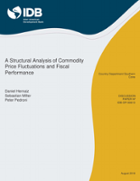A Structural Analysis of Commodity Price Fluctuations and Fiscal Performance
Date
Aug 2018
A number of policy discussions in macroeconomics have to do with the impact of commodity price fluctuations on fiscal policy in commodity exporting countries. Commodity price movements, however, have different sources depending on the nature of economic shocks. This paper employs a heterogeneous panel SVAR approach that addresses this issue in three stages. Specifically, our empirical approach is motivated by an economic model in which small open economies export commodities to the rest of the world and real responses depend on the source of the shocks as well as the nature of the exchange rate regime. We implement our empirical approach by identifying two sets of structural shocks that affect international commodity prices, four at the global level and four at the commodity market level. We study the effect of these shocks on real fiscal expenditure and other country-specific macroeconomic domestic variables. We then exploit the heterogeneity of our dynamic estimates at the country and commodity level to study the interactions between real expenditure and the exchange rate regime in the face of commodity price shocks. On this basis we find that: (i) countries with more flexible exchange rate regimes tend to accumulate fiscal space in response to commodity price shocks more often than countries with less flexible regimes; (ii) real expenditure fluctuations are smaller in countries that decrease spending in response to a commodity price shock than in countries that increase it; (iii) in the group of countries that increase spending in response to a commodity price shock, fluctuations tend to be much smaller when the exchange rate regime is most flexible.




